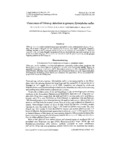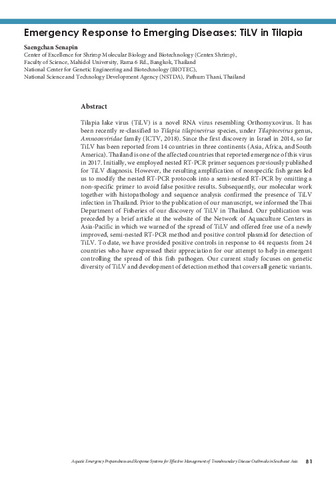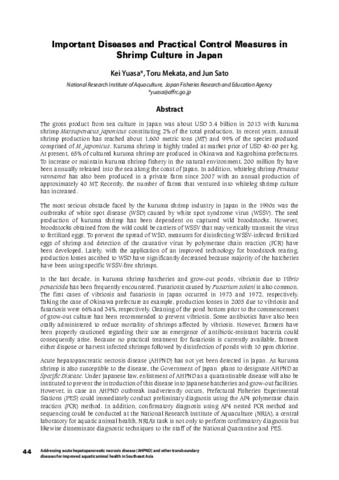Phylogeographic patterns in the Philippine archipelago influence symbiont diversity in the bobtail squid-Vibrio mutualism
Share
| dc.contributor.author | Coryell, Randy L. | |
| dc.contributor.author | Turnham, Kira E. | |
| dc.contributor.author | de Jesus Ayson, Evelyn G. | |
| dc.contributor.author | Lavilla-Pitogo, Celia | |
| dc.contributor.author | Alcala, Angel C. | |
| dc.contributor.author | Sotto, Filippina | |
| dc.contributor.author | Gonzales, Benjamin | |
| dc.contributor.author | Nishiguchi, Michele K. | |
| dc.date.accessioned | 2018-07-23T07:15:37Z | |
| dc.date.available | 2018-07-23T07:15:37Z | |
| dc.date.issued | 2018 | |
| dc.identifier.citation | Coryell, R. L., Turnham, K. E., de Jesus Ayson, E. G., Lavilla-Pitogo, C., Alcala, A. C., Sotto, F., ... Nishiguchi, M. K. (2018). Phylogeographic patterns in the Philippine archipelago influence symbiont diversity in the bobtail squid-Vibrio mutualism. Ecology and Evolution, 8(15), 7421-7435. | en |
| dc.identifier.uri | http://hdl.handle.net/10862/3326 | |
| dc.description.abstract | Marine microbes encounter a myriad of biotic and abiotic factors that can impact fitness by limiting their range and capacity to move between habitats. This is especially true for environmentally transmitted bacteria that cycle between their hosts and the surrounding habitat. As geologic history, biogeography, and other factors such as water temperature, salinity, and physical barriers can inhibit bacterial movement to novel environments, we chose to examine the genetic architecture of Euprymna albatrossae (Mollusca: Cephalopoda) and their Vibrio fischeri symbionts in the Philippine archipelago using a combined phylogeographic approach. Eleven separate sites in the Philippine islands were examined using haplotype estimates that were examined via nested clade analysis to determine the relationship between E. albatrossae and V. fischeri populations and their geographic location. Identical analyses of molecular variance (AMOVA) were used to estimate variation within and between populations for host and symbiont genetic data. Host animals demonstrated a significant amount of variation within island groups, while symbiont variation was found within individual populations. Nested clade phylogenetic analysis revealed that hosts and symbionts may have colonized this area at different times, with a sudden change in habitat. Additionally, host data indicate restricted gene flow, whereas symbionts show range expansion, followed by periodic restriction to genetic flow. These differences between host and symbiont networks indicate that factors “outside the squid” influence distribution of Philippine V. fischeri. Our results shed light on how geography and changing environmental factors can impact marine symbiotic associations at both local and global scales. | en |
| dc.language.iso | en | en |
| dc.publisher | Wiley Open Access | en |
| dc.relation.uri | https://onlinelibrary.wiley.com/doi/epdf/10.1002/ece3.4266 | |
| dc.rights.uri | http://creativecommons.org/licenses/by/4.0/ | |
| dc.subject | Phylogeography | en |
| dc.subject | squids | en |
| dc.subject | Vibrio | en |
| dc.subject | Philippines | en |
| dc.title | Phylogeographic patterns in the Philippine archipelago influence symbiont diversity in the bobtail squid-Vibrio mutualism | en |
| dc.type | Article | en |
| dc.citation.volume | 8 | |
| dc.citation.issue | 15 | |
| dc.citation.spage | 7421 | |
| dc.citation.epage | 7435 | |
| dc.citation.journalTitle | Ecology and Evolution | en |
| dc.subject.asfa | symbiosis | en |
| dc.identifier.essn | 2045-7758 | |
| dc.identifier.doi | 10.1002/ece3.4266 | |
| dc.subject.scientificName | Euprymna albatrossae | en |
| dc.subject.scientificName | Vibrio fischeri | en |
Files in this item
| Files | Size | Format | View |
|---|
This item appears in the following Collection(s)
-
AQD Journal Articles [1223]
These papers were contributed by AQD staff to various national and international journals




